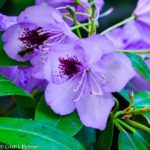
Root rots caused by Phytophthora species are often not noticed until foliar symptoms of wilting and stunting are observed. Phytophthora root rots are difficult to manage there are multiple species with differential sensitivities to fungicides.Plus, they are classified as Oomycetes in the kingdom Chromista, commonly known as water molds, and can have a propensity to develop resistance to single site mode of action fungicides. Thus, Phytophthora diseases have been prioritized for research periodically at IR-4 workshops since 2003. From 2003 to 2015, 74 products representing 65 active ingredients were tested through the IR-4 Program as drench or foliar applications against eleven Phytophthora species causing root rots and stem/leaf blights in a total of 926 trials. Phytophthora species tested included: P. cactorum, P. cinnamomi, P. citricola, P. cryptogea, P. drechsleri, P. nicotianae/parasitica, P. palmivora, P. plurivora, P. ramorum, P. syringae, and P. tropicalis. For certain more prevalent and well-studied species, multiple products within several modes of action exhibited good to excellent management: P. cinnamomi, P. cryptogea, P. drechsleri, P. nicotianae, P. palmivora, P. ramorum, and P. tropicalis. For P. cactorum, none of the experiments provided separation among the treatments and controls. Control of P. cinnamomi root rot was achieved primarily with drench applications onto azaleas. When this pathogen was tested on rhododendrons, the data were either inconclusive or the products did not perform as well as on azaleas with the exception of Magellan and Fenamidone. For P. citricola, Adorn and the phosphorus acid generators provided good to great efficacy, but none of the typical oomycete fungicides were acceptable. For P. drechsleri root rot, the good to excellent efficacy was achieved with several products including BioPhos, Segway, Stature DM, and Terrazole. For P. nicotianae, consistent efficacy across crops was difficult to achieve, but the best performers included Adorn, Aliette, Alude, Biophos, Fenamidone, Insignia, Micora Segway, Stature DM, Subdue MAXX, and Vital. For P. ramorum blights, Subdue MAXX provided the most consistent control. Adorn, Fenamidone, Insignia, Segway, and Stature also provided good control. For P. plurivora, 7 products provided good to excellent activity, but only two experiments have been completed so far. For P. syringae, only the phosphorous acid generaters provided acceptable reduction in disease in two experiments. For P. tropicalis, the best control was achieved with Adorn and Stature. Several products have good to excellent efficacy across multiple Phytophthora species: Adorn, Disarm, Fenstop, Micora, Orvego, Segway, Stature, and Subdue Maxx, plus certain phophorous acid generating products.
